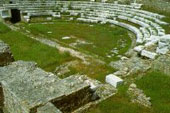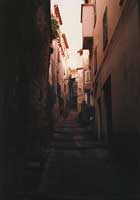Ventimiglia
 Ventimiglia
that is the rise of the Intemeli from the name Ligurian Albium Intemelium,
capital some Ligurian Intemeli. Under the dominion in Rome, the name shortened
in Albintimilium and in the Middle Ages, he changed in Ventimiglia. As
regards the name of the town other fanciful learned interpretations on
an antiromano hero, Intemelion exist. The original settlement Ligurian,
that was in the low part of the town, was replaced by the castrum of Albintimilium,
strategic knot of the august street Iulia. The decay of the Roman empire
and the barbaric invasions determined the ruin of the town. Between the
remains of the ancient settlement, only urbanized in our century, the
most important one is the Roman theatre. To guarantee it greater one capacity
defensive, in the high Middle Ages, the population moved century, place
of business of Ventimiglia that extended its jurisdiction accounts on
a wide territory in the
Ventimiglia
that is the rise of the Intemeli from the name Ligurian Albium Intemelium,
capital some Ligurian Intemeli. Under the dominion in Rome, the name shortened
in Albintimilium and in the Middle Ages, he changed in Ventimiglia. As
regards the name of the town other fanciful learned interpretations on
an antiromano hero, Intemelion exist. The original settlement Ligurian,
that was in the low part of the town, was replaced by the castrum of Albintimilium,
strategic knot of the august street Iulia. The decay of the Roman empire
and the barbaric invasions determined the ruin of the town. Between the
remains of the ancient settlement, only urbanized in our century, the
most important one is the Roman theatre. To guarantee it greater one capacity
defensive, in the high Middle Ages, the population moved century, place
of business of Ventimiglia that extended its jurisdiction accounts on
a wide territory in the  valleys
of the Roja, on the hill where he became, in the XI some Nervia and some
Bevera. The apex of the hill was surrounded by walls, on the sommità of
what, near the cathedral and the episcopal palace, one was erecting the
castle of the accounts. In the 1261 there fù the subdivision of the county
between the dominations, the Doria and the Grimaldi one shared out Genoa
and Provence while to Ventimiglia accounts came assigned the northern
part about the curtain hill. Ventimiglia went by under the dominion in
Genoa that, in the 1526, did not however safeguard her from the attack
some Grimaldi. The wall boundary is for coupons still drawn visible he
and preserves some ancient passage, how he takes Piedmont and takes Nice.
valleys
of the Roja, on the hill where he became, in the XI some Nervia and some
Bevera. The apex of the hill was surrounded by walls, on the sommità of
what, near the cathedral and the episcopal palace, one was erecting the
castle of the accounts. In the 1261 there fù the subdivision of the county
between the dominations, the Doria and the Grimaldi one shared out Genoa
and Provence while to Ventimiglia accounts came assigned the northern
part about the curtain hill. Ventimiglia went by under the dominion in
Genoa that, in the 1526, did not however safeguard her from the attack
some Grimaldi. The wall boundary is for coupons still drawn visible he
and preserves some ancient passage, how he takes Piedmont and takes Nice.
 Of
remarkable interest am the Romanesque cathedral (sec. XI XIII, with datable
below structures between the IX and the century x, the half bell tower
Some XII century, the baptistery (1100) indoors of what one can admire
Madonna's painting with Barnabas's child from Modena, the medieval public
palace, the magistrate's of the abundance or the parliament, fourteenth-century
loggia, the theatre and the oratory of San second. Always in the historical
center remember San Francesco church and San Michele church (some XII
sec.)With a crypt on Roman columns. In front of San Michele, in the door
Piedmont, neighbourhood he finds it the "Funtanin", sixteenth-century
public picturesque fountain. To Ventimiglia were born the historian Girolamo
Rossi (1831-1914), author of numerous publications and discoverer in 1876,
some Roman theatre, the journalist and novelist Alessandro Varaldo, authors'
and of the publishers (SIAE) and in the 1821 Giuseppe Biancheri, Italian
society's founder deputized for beyond half century one beat not to give
Nice to France. Between the historical personalities one remember father
angelic Aprosio (1607-1681), a friar Augustinian to what one owes the
one constitution of the more ancient libraries of Italy: The library Aprosiana.
Of
remarkable interest am the Romanesque cathedral (sec. XI XIII, with datable
below structures between the IX and the century x, the half bell tower
Some XII century, the baptistery (1100) indoors of what one can admire
Madonna's painting with Barnabas's child from Modena, the medieval public
palace, the magistrate's of the abundance or the parliament, fourteenth-century
loggia, the theatre and the oratory of San second. Always in the historical
center remember San Francesco church and San Michele church (some XII
sec.)With a crypt on Roman columns. In front of San Michele, in the door
Piedmont, neighbourhood he finds it the "Funtanin", sixteenth-century
public picturesque fountain. To Ventimiglia were born the historian Girolamo
Rossi (1831-1914), author of numerous publications and discoverer in 1876,
some Roman theatre, the journalist and novelist Alessandro Varaldo, authors'
and of the publishers (SIAE) and in the 1821 Giuseppe Biancheri, Italian
society's founder deputized for beyond half century one beat not to give
Nice to France. Between the historical personalities one remember father
angelic Aprosio (1607-1681), a friar Augustinian to what one owes the
one constitution of the more ancient libraries of Italy: The library Aprosiana.
 Between
the demonstrations more important of Ventimiglia one signal the party
of the battle of the flowers, in June, and the palio seafaring in August.
The plates of the local kitchen are the rabbit and the gilthead to the
ventimigliese, the barbagiuai (fried full pumpkin ravioli in oil), the
pisciadella (pizza to the anchovy and onion from the drenched pasta with
tins), the fritter (wrung with filling of vegetableses) and as cakes them
castagnole and the grummets. Pregious wines are the Rossese and the Vermentino.
Between
the demonstrations more important of Ventimiglia one signal the party
of the battle of the flowers, in June, and the palio seafaring in August.
The plates of the local kitchen are the rabbit and the gilthead to the
ventimigliese, the barbagiuai (fried full pumpkin ravioli in oil), the
pisciadella (pizza to the anchovy and onion from the drenched pasta with
tins), the fritter (wrung with filling of vegetableses) and as cakes them
castagnole and the grummets. Pregious wines are the Rossese and the Vermentino.
 To
few kilometers in direction France we find the grottos some red leaps,
of archaeological big interest. The paleo-ethnologic importance was already
shown XVIII in the century by the naturalist de Sassure. Excavations took
remarkable one amount of finds, today preserved to the prehistoric, founded
Thomas Hanbury from sir at the end of the eighthundred national museum
to the light. The museum picks up ornaments, fossils, utensils in stone.
Always in this zone were found it numerous remains going up again to the
superior Paleolith.
To
few kilometers in direction France we find the grottos some red leaps,
of archaeological big interest. The paleo-ethnologic importance was already
shown XVIII in the century by the naturalist de Sassure. Excavations took
remarkable one amount of finds, today preserved to the prehistoric, founded
Thomas Hanbury from sir at the end of the eighthundred national museum
to the light. The museum picks up ornaments, fossils, utensils in stone.
Always in this zone were found it numerous remains going up again to the
superior Paleolith.
On the outskirts of the red leaps,
and more precisely to Mortola the gardens Hanbury and the villa constitute
an artistic complex and Naturalistic of big interest. In 1867 Sir Thomas
Hanbury, on holiday on the blue coast, remained struck by the head Mortola
beauty and started buying some ground lots up to arrive per eighteen present
hectares. Sir Thomas thought, I endorse the climate of the zona, to do
a garden that picked up exotic plants Different coming from countries
mores. Her Mediterranean stain is disconcerted with the more disparate
exotic kinds, one picked up of about 7000 grieved cultivated in pien'
air do an only botanical park to the world. Of the complex do leaves the
collection of roses, the Japanese garden, the Australian  forest
and the perfume garden. The arrangement of the garden preserved the ancient
street Julia August, the flat areas, the ancient support walls and the
building walled old woman. Him obbiettivo of the family Hanbury was that
one to safeguard and support the spontaneous vegetation and autoctona
in the zones in bad more condition of the property. Indoors of the gardens
sculptural elements pretty, pretty temples pretty, park benches in stone,
fountains and basins are numerous presents. The villa, in marquiss' Orengo
of Ventimiglia, origin was kept and the arcade to arcs, the arcade of
entry, the terraces were inserted and was made the rise of the tower.
Him other buildings indoors of the garden were turned into pretty premises
of service, the farms, the house, the country house, the house of the
gardeners, the vaccheria, the house small Christmases small, the stable,
the hayloft and the habitation of the keepers. Today, for will of the
family Hanbury, gardens belong to the been Italian and their conservation
and entrusted some university of Genoa to the botany institute. The visit
to the gardens Hambury is possible all the days give her 10:00 to the
16:00 better, the periods are, clearly, those ones some fioriture.
forest
and the perfume garden. The arrangement of the garden preserved the ancient
street Julia August, the flat areas, the ancient support walls and the
building walled old woman. Him obbiettivo of the family Hanbury was that
one to safeguard and support the spontaneous vegetation and autoctona
in the zones in bad more condition of the property. Indoors of the gardens
sculptural elements pretty, pretty temples pretty, park benches in stone,
fountains and basins are numerous presents. The villa, in marquiss' Orengo
of Ventimiglia, origin was kept and the arcade to arcs, the arcade of
entry, the terraces were inserted and was made the rise of the tower.
Him other buildings indoors of the garden were turned into pretty premises
of service, the farms, the house, the country house, the house of the
gardeners, the vaccheria, the house small Christmases small, the stable,
the hayloft and the habitation of the keepers. Today, for will of the
family Hanbury, gardens belong to the been Italian and their conservation
and entrusted some university of Genoa to the botany institute. The visit
to the gardens Hambury is possible all the days give her 10:00 to the
16:00 better, the periods are, clearly, those ones some fioriture.
photos | views |